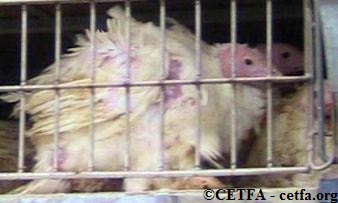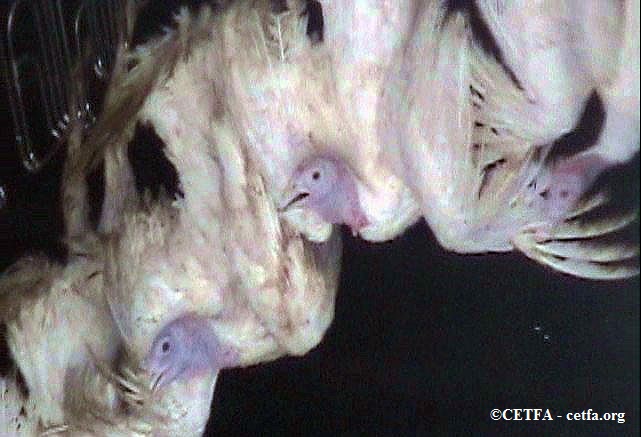In 2012, Canadians consumed 142.0 million kg of turkey.
Modern turkeys have been genetically selected for high growth rate, and they are now only 3-4 months old when slaughtered. But because their bone structure has not been able to adapt to their massive bodies, painful and crippling leg disorders are common in the birds.
Most of the birds undergo elective surgeries without anaesthetics or analgesics. Young turkeys often have the ends of their toes cut or microwaved off (although we’ve seen entire digits missing). The males may have their snoods cut off with a regular pair of scissors; and all have partial beak amputation.
Debeaking has been shown to be incredibly painful as turkey’s beaks contain more nerve endings than our finger tips. The debeaked birds suffer phantom pain and some develop tumours of the beak as the nerve endings attempt to regenerate. Many countries now recognizing the cruelty of such practices and have banned the practice of debeaking.
High levels of ammonia and dust in the sheds turkeys are raised in cause a build-up of peritoneal cavity fluid and respiratory disease. The ammonia dissolves on their mucous membranes and eyes, producing ammonium hydroxide, an acid that causes ammonia-burns. These ammonia burns and ulcerations also occur on the turkeys’ rears, breasts and feet.
On the day of slaughter, the turkeys are often brutally loaded by unskilled young men paid by the trailer-load, not the hour, encouraging speed over care of the birds (Watch CETFA’s videos: Loading of turkeys for Granny’s in MB, and Granny’s poultry violations update). The birds are grabbed by their legs and carried, two per hand then thrown into the crates. Many birds are injured in the process with fractures to the legs and pelvis, hip dislocation, tendon or ligament trauma, hemorrhaging, detached femurs, ruptured livers, crushed heads and dislocated necks. Given that these birds are already suffering some form of limb pain, their suffering is enormous.
While poultry are included under Canada’s humane transport and slaughter regulations, the chronic and severe violations occurring daily are not, and historically have never been enforced. Turkeys are regularly overloaded onto inproper conveyances that do not afford them protection from the elements or enough headroom. The crate design is also improper, not allowing each bird to be accessible to be euthanized or removed should they become injured.
At the slaughterhouse these crippled, injured and traumatized birds will be roughly live-hung, upside down by their feet. Many of the birds attempt to right themselves, but those who struggle are at greatest risk of further injuries, such as femur dislocation, which in a third of cases will be forced into the abdominal cavity.
The live-suspension of poultry has been conclusively determined to be intensely painful but for birds as large as turkeys, some of which may weigh up to 60 lbs, the pain is severe. These birds may weigh 10-15 lbs more than lambs, yet it is illegal in Canada to live-suspend a conscious lamb. Why is it legal to do the same to a turkey, which is an even larger animal?
Almost all turkey slaughterhouses in Canada use electrified stun baths to “stun” the birds. However, it has been conclusively determined these baths do not render the birds unconscious, but rather simply immobilize them preventing excessive struggling. The use of electricity as a method of euthanasia at animal shelters has been made illegal in Canada, so again we must ask, why is it
allowed for use on turkeys?
The birds who manage to avoid the stun bath by raising their heads will not be paralyzed, and when sent through the spinning neck blades may miss them – some partially, some fully. These birds do not bleed out sufficiently before being thrown into the scald bath where they are scalded alive. Canadian Food Inspection Agency records indicate that over 250,000 birds die in this unfathomably cruel manner each year.
The live-scalding of turkeys is not only a massive welfare concern but has become a major food safety issue as well. A study in 2000 to determine the cause of the extraordinarily high rate of Salmonella bacteria commonly found on poultry carcasses found that 75% of scald tank water samples tested were salmonella positive. The salmonella was found to have been introduced through the excreta of still-live birds thrown into the scald tank.
CETFA is calling upon the federal government to finally do what is right and begin enforcing the transport and humane slaughter regulations for turkeys. Turkeys are supposed to be protected against such cruelties, yet never are.
We are also calling upon the turkey producers to phase out cruel on-farm practices such as detoeing, debeaking, and desnooding of turkeys. The poultry transportation and slaughter industry must also take responsibility and develop better methods of
loading turkeys onto trailers, protecting them during transport and ensuring they are able to stand fully as federal regulations dictate.
And finally, slaughter plants such as Granny’s (where some of the above images were taken) must phase out the use of their cruel method of slaughter. Electric stun baths must be replaced by controlled atmosphere killing which uses nonaversive, inert gases (NOT carbon dioxide) to kill the birds while still in their transport crates, meaning less handling. The inert gas is quick and relatively painless – the birds do not pile or panic. Many companies are moving to this much more humane method and even entire countries have made the electric stun bath illegal, recognizing the unnecessary cruelty it inflicts.
Note:
For more information about the slaughter of poultry, read CETFA’s report Broken Wings: The Breakdown of Animal Protection in the Transportation and Slaughter of Meat Poultry in Canada.






